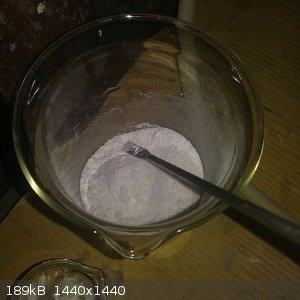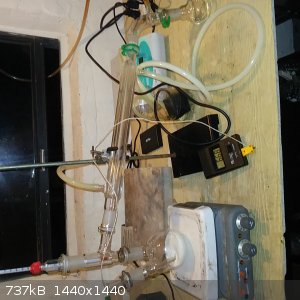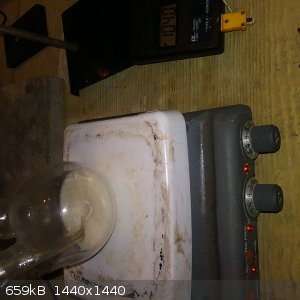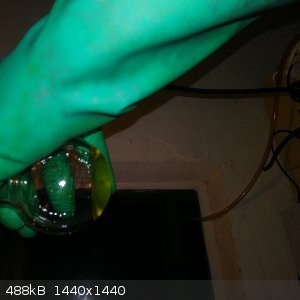VSEPR_VOID
National Hazard
   
Posts: 719
Registered: 1-9-2017
Member Is Offline
Mood: Fullerenes
|
|
Sodium Ethyl Sulfate Report
A three neck 500 mL RBF was charged with 128 grams of ethyl alcohol (anhydrous >99.9% pure) and 120 grams of drain opener sulfuric acid. The acid
was added slowly by a pressure equalizing funnel. At the end of the addition the temperature approached 70 C.
The solution was refluxed for 3 hours. The solution appeared a very light redish-brown. This is a solution of ethanol, sulfuric acid, and ethyl
hydrogen sulfate.
The reaction mixture was quenched with 600 mL of cold water.
92 grams of calcium carbonate is added slowly over 60 minutes. The addition was done one gram or so at a time by paper to ensure none of it was
encapsulated in calcium sulfate, reducing its activity.
The goal of this step is to neutralize the remaining sulfuric acid. Calcium ethyl sulfate is soluble. The addition was done correctly is bubble stops
after several minutes once the addition of the calcium carbonate is complete.
The mixture is heated to 60 C and then filtered.
The solution is treated with a solution of sodium carbonate until is basic and no more calcium carbonate precipitates. It is important to do this
slowly so as not to add too much. This greatly affects the purity of the final product.
The solution is then filtered again and then evaporated by a water bath over 12 hours.
The remaining 50 mL of solution was then evaporated at 70 C until crystals started to form and the solution became thick. The mixture was then left to
cool. When at room temperature, small white crystals smelling of mint form.
The product was found to contain some sodium carbonate as it reacted somewhat with HCl(aq) to evolve CO2 and give a light yellow solution.
Theory: 180 grams
Actual: 76.8 grams
Percent Yield (100% purity): 42.8%

Within cells interlinked
Within cells interlinked
Within cells interlinked
|
|
|
DavidJR
National Hazard
   
Posts: 908
Registered: 1-1-2018
Location: Scotland
Member Is Offline
Mood: Tired
|
|
Wouldn't you also get diethyl ether?
|
|
|
XeonTheMGPony
International Hazard
    
Posts: 1640
Registered: 5-1-2016
Member Is Offline
Mood: No Mood
|
|
not at those temperatures to any significant degree
|
|
|
Waffles SS
Fighter
   
Posts: 998
Registered: 7-12-2009
Member Is Offline
|
|
I think it depend on reflux temp(diethyl ether formed at temp ~130C).
One of my interesting goal is making Nitroethane from Sodium hydrogen sulfate.unfortunately i was unsuccessful so far.
Making Sodium hydrogen sulfate is important step in this synthesis and i tried Sodium hydrogen sulfate method (according to US3024263) without any
success.
Always i am looking for good yield and trustable method for making Sodium ethyl sulfate
[Edited on 23-10-2018 by Waffles SS]
Chemistry = Chem + is + Try
|
|
|
VSEPR_VOID
National Hazard
   
Posts: 719
Registered: 1-9-2017
Member Is Offline
Mood: Fullerenes
|
|
Quote: Originally posted by Waffles SS  |
I think it depend on reflux temp(diethyl ether formed at temp ~130C).
One of my interesting goal is making Nitroethane from Sodium hydrogen sulfate.unfortunately i was unsuccessful so far.
Making Sodium hydrogen sulfate is important step in this synthesis and i tried Sodium hydrogen sulfate method (according to US3024263) without any
success.
Always i am looking for good yield and trustable method for making Sodium ethyl sulfate
[Edited on 23-10-2018 by Waffles SS] |
I have made nitroethane in small amounts before from the destructive distillation of sodium ehtyl sulfate and sodium nitrite. The resulting
nitroethane has a wonderful color when burnt, a bright white light.
Within cells interlinked
Within cells interlinked
Within cells interlinked
|
|
|
monolithic
Hazard to Others
  
Posts: 436
Registered: 5-3-2018
Member Is Offline
Mood: No Mood
|
|
Have you ever tried the sulfamic acid route?http://www.sciencemadness.org/talk/viewthread.php?tid=15837&goto=search&pid=204859
More information at https://www.hyperlab.info/inv/index.php?s=7396afd10e0ac1d9f2... (see the post by bvz on Mar 21 2011, 12:24)
[Edited on 24-10-2018 by monolithic]
[Edited on 24-10-2018 by monolithic]
|
|
|
VSEPR_VOID
National Hazard
   
Posts: 719
Registered: 1-9-2017
Member Is Offline
Mood: Fullerenes
|
|
I have not tried that yet, but I am interested in any route involving ethyl nitrite or gaseous nitric acid. I know that some members have been working
on that. They are making good progress.
This method takes a lot of time to do, especially the addition of the calcium carbonate. The yield is okay, but there are sodium carbonate impurities.
Within cells interlinked
Within cells interlinked
Within cells interlinked
|
|
|
AvBaeyer
National Hazard
   
Posts: 649
Registered: 25-2-2014
Location: CA
Member Is Offline
Mood: No Mood
|
|
Is your experimental procedure from a published source? If so, give a reference.
What are your criteria of the chemical identity and purity of your final product? Your final product could be largely sodium sulfate. How do you show
it is not? A mint-like smell is not an acceptable proof of identity. I would not take it on faith that you have made what you claim based on the
experimental details provided. My aim here is to introduce a bit of rigor into your method so that others may want to confidently reproduce your
experiment.
AvB
|
|
|
JJay
International Hazard
    
Posts: 3440
Registered: 15-10-2015
Member Is Offline
|
|
Check the melting point and the specific gravity of a saturated solution. It should be clear when melted. The specific gravity of the saturated
solution (56% IIRC) at 20 C should be around 1.34 IIRC, and the melting point is 86 C.
Also, refluxing is counterproductive; a temperature of 70 C for 10 minutes is sufficient to reach equilibrium. You can also slimply let it sit
overnight at 25 C. Temperatures above 80 C before neutralization lead to sideproducts that reduce yields.
Personally, I wouldn't bother with the boiling water bath, but if you have a rotovap, you could be the envy of all your neighbors.
|
|
|
nimgoldman
Hazard to Others
  
Posts: 303
Registered: 11-6-2018
Member Is Offline
|
|
Thanks for the writeup. I will try this method too.
My target is also nitroethane. Since I have plenty of bromoethane, I will try the Victor Meyer reaction, i.e. reacting haloethane with silver nitrite in diethyl ether or THF.
Silver nitrite can be made from (probably) more accessible silver nitrate and sodium nitrite.
I already tried the Kornblum-modified synthesis using bromoethane and silver nitrite in DMF or DMSO, but it failed miserably. The yield is low and the
workup is painful.
I finally managed to make a little bit of nitroethane (about 2 mL), but there is a slight chance it is contaminated with higly toxic nitrosamine,
hence I will probably burn it.
[Edited on 25-10-2018 by nimgoldman]
|
|
|
VSEPR_VOID
National Hazard
   
Posts: 719
Registered: 1-9-2017
Member Is Offline
Mood: Fullerenes
|
|
Quote: Originally posted by JJay  | Check the melting point and the specific gravity of a saturated solution. It should be clear when melted. The specific gravity of the saturated
solution (56% IIRC) at 20 C should be around 1.34 IIRC, and the melting point is 86 C.
Also, refluxing is counterproductive; a temperature of 70 C for 10 minutes is sufficient to reach equilibrium. You can also slimply let it sit
overnight at 25 C. Temperatures above 80 C before neutralization lead to sideproducts that reduce yields.
Personally, I wouldn't bother with the boiling water bath, but if you have a rotovap, you could be the envy of all your neighbors.
|
Here is the source, which I modified slightly for a larger scale
To prepare the sodium salt of ethyl hydrogen sulfate, a mixture of alcohol and H2SO4 is boiled under reflux, cooled, and an excess of calcium
carbonate is added. The ethyl hydrogen sulfate is converted into the soluble calcium ethyl sulfate, whilst the excess of H2SO4 is removed as insoluble
calcium sulfate. The aqueous filtrate is then mixed with just sufficient sodium carbonate to give sodium ethyl sulfate, the insoluble calcium
carbonate being now filtered off. The solution of sodium ethyl sulfate can be concentrated on the water-bath without appreciable hydrolysis, and the
sulfate finally crystallized out.
Place 40ml (32g) of rectified spirit in a 250ml round-bottomed flask, and slowly add. 16ml (30g) of concentrated sulfuric acid, keeping the liquid in
the flask well shaken throughout the addition to ensure thorough mixing. Fit a reflux condenser to the flask, and heat the latter on a gauze so that
the mixture boils gently for 45 minutes. Then cool the product and pour it into 200ml of cold water contained in a large (8-inch) evaporating-basin or
in a shallow earthenware dish. Now add 23g of finely powdered calcium carbonate with stirring to the acid solution. It is essential to add the calcium
carbonate as a fine stream of powder, and to stir the latter immediately into the bulk of the solution: for this purpose, it is best to sift the
carbonate through a fine sieve directly into the liquid, or alternatively to add it from a spatula, tapping the latter gently over the liquid to
ensure steady addition of the finely powdered chalk. If the carbonate is added carelessly several grams at a time, it becomes rapidly covered with
insoluble calcium sulfate, which protects it from further reaction: in these circumstances, at least 10 times the theoretical quantity of the
carbonate may be required and the evolution of carbon dioxide may continue for several hours. The addition of the calcium carbonate should take about
30 minutes, and the well-stirred mixture should finally be neutral to litmus-paper. Now heat the mixture on a water-bath, using a thermometer as a
stirrer, until the temperature reaches 60°C, and then filter at the pump through a wide Buchner funnel: at this temperature, filtration should be
rapid. Finally wash the residue of calcium sulfate on the filter with a small quantity of hot water, adding the wash-water to the main filtrate. In
order to convert the calcium ethyl sulfate to sodium ethyl sulfate, add a concentrated aqueous solution of sodium carbonate cautiously drop by drop to
the well-stirred filtrate until a drop of the latter withdrawn on a glass rod is just sufficiently alkaline to turn red litmus-paper blue. Then filter
the solution at the pump, and wash the residual calcium carbonate again with a small quantity of water. Evaporate the filtrate on a water-bath until a
drop withdrawn on a rod crystallizes on cooling: then allow the solution to stand until almost cold, and finally chill it thoroughly in ice-water. (If
the ice-water cooling is omitted, large well-developed colorless crystals of sodium ethyl sulfate will finally separate.) Filter off the crystals at
the pump, drain, and dry over calcium chloride in a desiccator. Yield about 12g. To obtain a second (but necessarily less pure) crop of the sulfate,
evaporate the filtrate further on the water-bath, and cool as before.
Source: https://www.erowid.org/archive/rhodium/chemistry/nitroalkane...
I am going to do the mp test first. I do not think my final product could be mainly sodium sulfate. I made sure to add a large excess of calcium
carbonate slowly for that reason. The pH of the solution after neutralization with calcium carbonate was bellow 7.
Within cells interlinked
Within cells interlinked
Within cells interlinked
|
|
|
JJay
International Hazard
    
Posts: 3440
Registered: 15-10-2015
Member Is Offline
|
|
That's basically just plagiarized from a really old and quite erroneous procedure on potassium ethyl sulfate (I forget the exact reference, but it's
easy to find). The second crop of crystals would actually be purer because of the high solubility of sodium ethyl sulfate.
Read this. It will tell you why refluxing is a bad idea: https://pubs.acs.org/doi/abs/10.1021/ja02248a014
|
|
|
JJay
International Hazard
    
Posts: 3440
Registered: 15-10-2015
Member Is Offline
|
|
Quote: Originally posted by nimgoldman  | Thanks for the writeup. I will try this method too.
My target is also nitroethane. Since I have plenty of bromoethane, I will try the Victor Meyer reaction, i.e. reacting haloethane with silver nitrite in diethyl ether or THF.
Silver nitrite can be made from (probably) more accessible silver nitrate and sodium nitrite.
I already tried the Kornblum-modified synthesis using bromoethane and silver nitrite in DMF or DMSO, but it failed miserably. The yield is low and the
workup is painful.
I finally managed to make a little bit of nitroethane (about 2 mL), but there is a slight chance it is contaminated with higly toxic nitrosamine,
hence I will probably burn it.
[Edited on 25-10-2018 by nimgoldman] |
Chem Player did it with ethyl iodide with silver nitrite in diethyl ether.
I'm not really sure why people want nitroethane so badly....
|
|
|
VSEPR_VOID
National Hazard
   
Posts: 719
Registered: 1-9-2017
Member Is Offline
Mood: Fullerenes
|
|
The mp came back good. It got gooey at about 40 C and was a thick liquid at 80 C.
Destructive distillation with 39.5 grams of sodium ethyl sulfate product, 25.75 g of sodium nitrite, and 16 grams of potassium carbonate (accidentaly
added too much, should be 8.5) gave a yellow oily distillate that burned with a white flame. Its smell is like rotten gasoline mixed with almonds.
I think I got about 10 mL, which would be a 50% yield.
Over all this method is a pain in the ass to do unless you do it on a large scale. Start with a few 100 mL of ethanol and drain opener, then go from
there. Do not reflux as someone said, just heat to 70 C for ten minutes. Once you get a solution of calcium ethyl sulfate, be very careful and titrate
it with sodium carbonate.
I think that we need a way of getting nitroethane from nitric/nitrous acid and ethanol. It would be amazing if we could just pass ethanol vapor
through hot nitric acid and a catalyst. I know that a forum member has been doing something like that, but the apparatus is enormous and expensive.
I think I saw anther method that involved sending ethyl nitrite over asbestos, but it required hundreds of feet of it. Maybe someone could do
something with a soxhlet extractor packed with asbestos.
[Edited on 25-10-2018 by VSEPR_VOID]
  
Within cells interlinked
Within cells interlinked
Within cells interlinked
|
|
|
JJay
International Hazard
    
Posts: 3440
Registered: 15-10-2015
Member Is Offline
|
|
Sodium ethyl sulfate monohydrate should melt sharply at 86 C, producing a waterlike liquid (clear, flowing, low viscosity).
I'm not sure what to think of the nitroethane experiment... do you have two layers in your product?
[Edited on 25-10-2018 by JJay]
|
|
|
Tsjerk
International Hazard
    
Posts: 3031
Registered: 20-4-2005
Location: Netherlands
Member Is Offline
Mood: Mood
|
|
Quote: Originally posted by VSEPR_VOID  | gave a yellow oily distillate that burned with a white flame. Its smell is like rotten gasoline mixed with almonds.
I think I got about 10 mL, which would be a 50% yield.
[Edited on 25-10-2018 by VSEPR_VOID] |
You definitely have to clean this product before you can call a yield, nitroethane is clear, non-vicious, colorless and doesn't smell bad.
|
|
|
VSEPR_VOID
National Hazard
   
Posts: 719
Registered: 1-9-2017
Member Is Offline
Mood: Fullerenes
|
|
I agree. I am going to wash it again, dry it, then distill.
There were not two layers in my product, which is a bit strange because I expected some water to come over.
In regards to the boiling point I assume this means that my product is contaminated with sodium carbonate. Sodium carbonate has some hydrates that
melt bellow 100 C. That is to be expected as I showed when I treated the sodium ethyl sulfate with acid.
Does anyone have some ideas on how to purify the sodium ethyl sulfate?
Within cells interlinked
Within cells interlinked
Within cells interlinked
|
|
|
JJay
International Hazard
    
Posts: 3440
Registered: 15-10-2015
Member Is Offline
|
|
Recrystalization from water by evaporation (you can use a water bath). Methanol/ether and ethanol have been reported to work.
|
|
|
VSEPR_VOID
National Hazard
   
Posts: 719
Registered: 1-9-2017
Member Is Offline
Mood: Fullerenes
|
|
What is sodium ethyl sulfates solubility in ether?
Within cells interlinked
Within cells interlinked
Within cells interlinked
|
|
|
JJay
International Hazard
    
Posts: 3440
Registered: 15-10-2015
Member Is Offline
|
|
Very low.
|
|
|